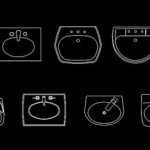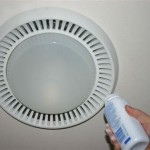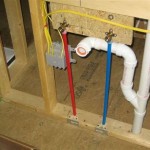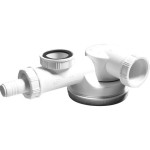Why Your Bathroom Smells Like Sewage
A bathroom that smells like sewage presents a significant and unpleasant issue for any homeowner. The foul odor not only detracts from the comfort and hygiene of the space but also potentially indicates underlying plumbing problems that require prompt attention. Identifying the source of the sewage smell is crucial for effective remediation. This article delves into several common causes of this problem, providing information that can assist in troubleshooting and resolving the issue.
Dry or Cracked Toilet Wax Ring
The toilet wax ring is a critical component in preventing sewage gases from escaping into the bathroom. This ring forms a seal between the base of the toilet and the drainpipe flange on the floor. Over time, the wax ring can dry out, crack, or become damaged, compromising the seal. This deterioration allows sewer gases, which are naturally produced by decomposing waste in the plumbing system, to seep into the bathroom.
Several factors can contribute to the degradation of the wax ring. Fluctuations in temperature and humidity can cause the wax to expand and contract, leading to cracks. The weight of the toilet itself, particularly if the toilet is not properly secured, can also put stress on the wax ring, accelerating its wear. Additionally, if the toilet has been recently moved or replaced without installing a new wax ring, the original ring may be compromised, increasing the likelihood of leaks and sewer gas escape.
Detecting a faulty wax ring often involves observing telltale signs around the base of the toilet. Water may leak onto the floor after flushing, indicating that the seal is not watertight. The presence of a persistent sewage odor, even after cleaning the bathroom thoroughly, is another strong indicator. In some cases, the toilet may rock or wobble slightly, suggesting that the wax ring is not providing adequate support and sealing.
Replacing the wax ring is a relatively straightforward plumbing task that can often be accomplished by a homeowner with basic DIY skills. The process involves disconnecting the water supply to the toilet, removing the toilet from the floor, scraping away the old wax ring, and installing a new ring. It is crucial to ensure that the new wax ring is properly seated and that the toilet is securely reattached to the floor. Applying caulk around the base of the toilet can further seal the connection and prevent future leaks.
Clogged or Improperly Vented Drain Pipes
The plumbing system relies on a network of drain pipes to efficiently remove wastewater and waste materials from the house. Proper venting is essential for maintaining the pressure balance within the drain pipes, allowing wastewater to flow smoothly and preventing sewer gases from being forced back into the living space. When drain pipes become clogged or vents are blocked, the system's functionality is compromised, potentially leading to sewage odors in the bathroom.
Clogs can form in drain pipes due to the accumulation of various materials, including hair, soap scum, food particles, and mineral deposits. Over time, these materials can build up, restricting the flow of water and creating a breeding ground for bacteria that produce foul odors. A partially clogged drain may allow some water to pass through, but it can trap debris and lead to the development of stagnant water, further contributing to the sewage smell.
Plumbing vents are designed to allow air to enter the drain pipes, equalizing the pressure and preventing a vacuum from forming. Without proper venting, the flushing of a toilet or the draining of a sink can create a suction effect that pulls water out of the P-traps (the curved section of pipe under the sink and toilet) leading to the sewer line. The P-trap's water barrier prevents sewage gasses from rising up into the bathroom. When the water seal is gone, the smell of sewer will enter the house.
Identifying clogged or improperly vented drain pipes involves observing the behavior of the plumbing fixtures. Slow drainage in sinks, showers, or tubs is a common sign of a clog. Gurgling sounds coming from the drains can indicate a venting problem or a partial blockage. In severe cases, wastewater may back up into the sink or toilet, signaling a significant obstruction in the drainpipe.
Addressing clogged drain pipes can involve using a plunger, drain snake, or chemical drain cleaner to dislodge the blockage. In some cases, it may be necessary to disassemble the drainpipe to physically remove the clog. For venting problems, it is essential to inspect the vent pipes on the roof for obstructions, such as bird nests or debris. A professional plumber can assess the venting system and make necessary repairs or modifications to ensure proper airflow.
Sewer Line Issues
The sewer line is the main pipe that carries all the wastewater from the house to the municipal sewer system or a septic tank. Damage to the sewer line, such as cracks, leaks, or collapses, can result in significant sewage leaks and widespread contamination, leading to a strong sewage odor both inside and outside the house.
Several factors can contribute to sewer line damage. Tree roots are a common culprit, as they can infiltrate the sewer line through small cracks or joints, eventually causing significant obstructions and structural damage. Soil shifting, due to earthquakes, weather changes, or construction activities, can also put stress on the sewer line, leading to cracks or breaks. Older sewer lines made of materials like clay or cast iron are particularly susceptible to deterioration over time.
Detecting sewer line problems often involves observing several warning signs. The presence of a persistent sewage odor in the bathroom, even after addressing other potential sources, is a strong indicator. Slow drainage in multiple fixtures throughout the house can suggest a blockage or leak in the main sewer line. Soggy patches or unusually lush vegetation in the yard may indicate a sewer leak beneath the ground.
Addressing sewer line problems typically requires the expertise of a professional plumber or sewer specialist. They can use video inspection equipment to examine the sewer line internally, identifying the location and extent of the damage. Depending on the severity of the problem, repairs may involve patching cracks, replacing sections of pipe, or relining the entire sewer line. In severe cases, it may be necessary to excavate and replace the entire sewer line.
Preventative measures can help minimize the risk of sewer line problems. Avoiding flushing non-biodegradable items, such as diapers and feminine hygiene products, can prevent clogs. Regularly scheduling a professional plumbing inspection can identify potential problems early on, before they escalate into major issues. Consider installing a root barrier around the sewer line to prevent tree root infiltration.
Mold and Mildew Growth
While sewage is the primary culprit in producing a sewage-like smell, the presence of mold and mildew, particularly in damp environments like bathrooms, can exacerbate the issue. Mold and mildew thrive in moist conditions and release volatile organic compounds (VOCs) that can contribute to unpleasant odors, sometimes resembling a musty or sewage-like smell.
Bathrooms are particularly susceptible to mold and mildew growth due to the high levels of humidity created by showers, baths, and leaky faucets. Poor ventilation can further exacerbate the problem, as it allows moisture to linger and promotes the growth of these microorganisms. Hidden leaks behind walls or under floors can also create a breeding ground for mold and mildew.
Detecting mold and mildew involves visually inspecting the bathroom for telltale signs. Look for dark spots or discoloration on walls, ceilings, floors, and grout. Pay particular attention to areas around showers, tubs, sinks, and toilets. A musty or earthy odor can also indicate the presence of mold and mildew.
Addressing mold and mildew requires removing the source of moisture and thoroughly cleaning the affected areas. Fix any leaks or plumbing problems that are contributing to the moisture. Improve ventilation by opening windows or using a bathroom fan. Scrub the affected surfaces with a mold-killing cleaner or a solution of bleach and water. In severe cases, it may be necessary to remove and replace mold-infested materials, such as drywall or flooring.
Preventative measures can help minimize the risk of mold and mildew growth. Wipe down surfaces after showering or bathing to remove excess moisture. Use a bathroom fan to improve ventilation. Regularly clean the bathroom with a mold-killing cleaner. Address any leaks or plumbing problems promptly.
Identifying the specific cause of a sewage smell in the bathroom requires a systematic approach, starting with the most common potential sources and progressing to more complex issues. While some problems, such as replacing a wax ring or unclogging a drain, can be addressed by homeowners, others, such as sewer line repairs, require the expertise of a qualified plumber. Addressing the problem promptly is essential to restore the comfort and hygiene of the bathroom and prevent further damage to the plumbing system.

Why Does My Toilet Smell Like Sewage 5 Causes Solutions

Why Does Bathroom Smell Like Sewage Crystal Blue
What To Do When You Notice A Sewer Smell In Bathroom Spaces Howstuffworks

Why Does My Bathroom Smell Like Sewage Metro Flow Plumbing

7 Causes Of A Sewer Smell In The Bathroom Hays

Why Does My Toilet Smell Like Sewage 5 Causes Solutions

Toilet Smell Likes Rotten Eggs Rainaldi Home Services

Five Reasons Your Bathroom Smells Like A Sewer The Plumbette

Smells Like Sewage Here S Why Simpson Plumbing Llc

Sewer Smell In Bathroom Solved Bob Vila







